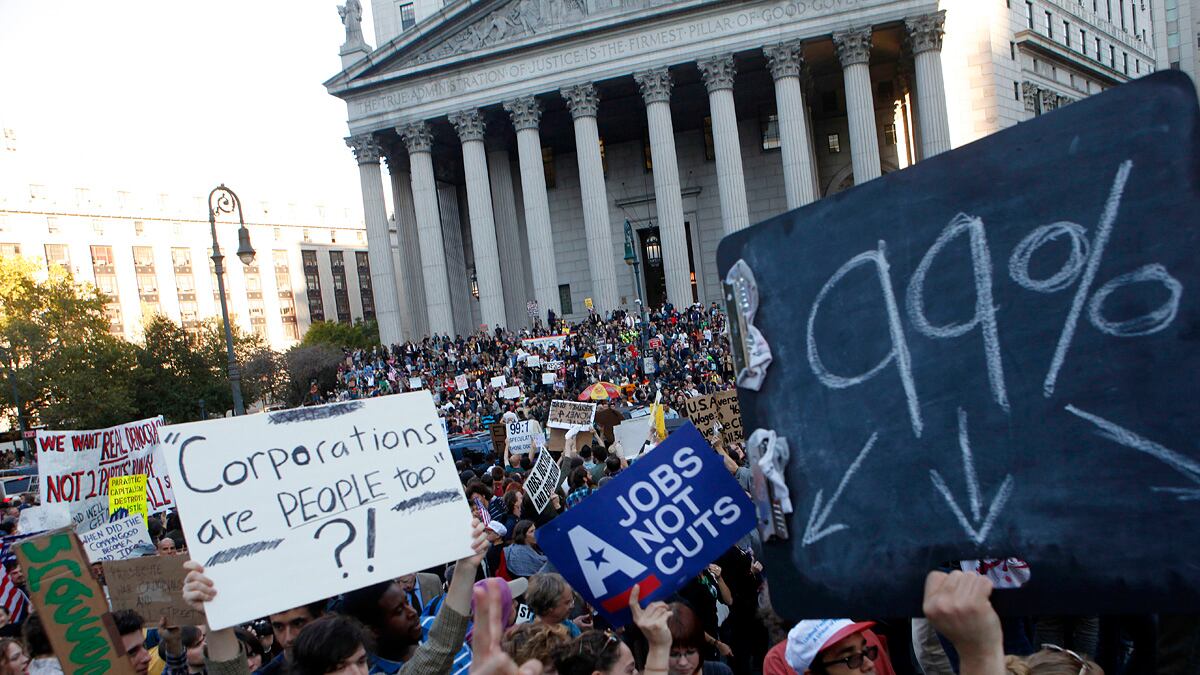Occupy Wall Street, which at first consisted of a thousand individuals brought together by a call in Adbusters magazine, plopped down in Manhattan’s Zuccotti Park on the afternoon of Sept. 17th and promptly rechristened the area Liberty Square. Their protest has grown to include such people as the Rutgers college student who was there Sept. 30th with his girlfriend, and gave an enthused critique of progressive movements past and present as it began to drizzle. Or the woman from New Orleans who said that after Hurricane Katrina sent floodwaters creeping right up to her floorboards, she’d predicted that a powerful popular movement would arise within three to five years. Seems she was off by one, she said.
Before noon on the 17th, a few protesters drifted on and around Wall Street. Many of them had not met before, and had no way of recognizing or signaling fellow protesters waiting in the area. No one had any sense of whether or not the protest would amount to anything more than a day of heated rhetoric after which everyone would trudge home dragging desultory signs behind them and reworking tired slogans in their solitude.
All other means of identifying protesters failing, I approached a young man with a thick book and dark eyeglasses. At 11 a.m., Wylie Wynshaw, a jazz musician from Brooklyn's Crown Heights, sat on a bench from which he could see the New York Stock Exchange, waiting. New York Police Department officers busily erected crowd-control barricades 15 feet away from where the 23-year-old read Canadian mystic Manly P. Hall’s 1928 work The Secret Teachings of All Ages. “They said there was supposed to be a sit-in,” he said of what he knew of plans for the protest. “We’ll occupy Wall Street. I guess that’s the battle cry for people in dire economic times.”
The area in front of the Exchange and side streets for a block or more in each direction had become a frozen zone. Without proof that one lived or worked on Wall Street, one was not allowed through, police said. Tourists were turned back in several languages. A woman walking her dog and talking on her cellphone inside the barricades looked bewildered. A group of Boy Scouts from Long Island seemed free to walk through without hindrance around 11:30.
A block or so east of where Wynshaw sat, Jason Ahmadi, a 26-year-old from California who said he’d spent the past month attending planning meetings and leaving his indent on friends’ couch cushions, also looked past the barricades toward the Exchange. Rarely is the building’s pediment eyed with such ardor by young men who do not dream of building default-swap empires. “A lot of us feel that there is a crisis in our economy, and that it was caused by the folks who do business here,” Ahmadi said.

Protesters gathered first at Bowling Green, toward Manhattan’s southern extremity. About 50 had gathered by 11:40, sitting on benches in the gated park, but within a half hour, their numbers had grown. Young men in keffiyehs, middle-aged folks with backpacks, and ebullient women marched around the Wall Street Bull. They held spirited informal readings from City Lights editions of Ginsberg, and opined on monetary policy.
The police presence around them was sizeable, but officers said that the only inconvenience so far had been keeping people on the sidewalk. That day, the New York Police Department solved the problem with the occasional polite reminder to not step into the path of moving vehicles. There has been much made of the idea that the protests are leaderless, but from the beginning men and women have been present to act decisively when a need arose and then recede. Rather than set an agenda for the protest, they act as custodians of its spirit. An early example is provided by Justin Wedes, who climbed atop a large green wood box at 12:45 to address the growing crowd outside Bowling Green. “Let’s keep it peaceful in this place,” the 25-year-old Brooklyn resident said, telling the protesters that their numbers would continue to grow. “Because we are calm, it is only the police who are a little stressed.”
As the police applied pressure around 1:30, protesters moved out of the small, gated park and on to the plaza in front of the adjacent Smithsonian Museum of the American Indian. “There’s a group of people who noticed we were being kettled,” said Richard Machado, a 20-year-old student from Glendale in Queens. If to take responsibility for others is to, even temporarily, assume the ambiguous mantle of leadership, this was Machado’s turn. “I don’t want anybody to get hurt,” he explained. The protesters claimed the museum’s wide front stairs and passed the conch, allowing anyone moved by the spirit to address the crowd.
For a little while, between two and three o’clock, activity slowed. There were many speeches, but nothing that might be said to have conjured forth the soul of Mario Savio, the '60s-era student orator whose “put your bodies upon the gears” speech stoked a fire in the belly of the Berkeley Free Speech Movement. There were representatives from the loose collective of activists called Anonymous, as well as Code Pink, ReportWrongdoing.com, and groups protesting the then-pending execution of Troy Davis. There was a man with a pink toy rifle. As dark clouds overhead loosed a few stray drops and one young man chanted “This is just a practice” through a bullhorn, home seemed to be beckoning.
Then, at 10 minutes before 3 p.m., the crowd decided to march north to Zuccotti Square, a privately held park for public use that was marked on quarter-sheet handouts distributed among the crowd. As they made their way up past the western entrance to Wall Street, where police stood in force, the crowd passed a bemused Bryan Barry, who had heard about the protests and come downtown to see what it was all about. The 26-year-old Park Slope resident said he was unemployed, but he didn’t see any reason why he should join the marchers.
“I don’t think it’s organized enough to make much of a statement,” Barry said as he reviewed the ragtag legions on parade. “I don’t think disorganization is a good thing at all. It has always been the problem with progressive movements.”
As the crowd settled in at Zuccotti Square, some of the older activists among them tried their hand at placing the events in historical perspective, disentangling how the whippersnappers around them compared to what they could recollect of their own revolutionary youth.
“For me, the focus needs to be on a larger transformation. I came of age during the '60s. There was a single topic, it was simple,” said Ted Schulman, 58, a multimedia producer who lives in the Financial District. He didn’t think there was much chance the protests would last past the evening of the 17th. “I live down here, and it pretty much rolls up at night. And if the police don’t want it to happen, they’ll pick off who’s around.”
Which is not to say that there are no more opportunities for civil disobedience in service of a cause. “The generation now is a lot like the '60s generation. These kids are post-9/11, post-Depression, and they really understand that things are bad.”
A bit dazed after the march to Zuccotti, the crowd milled around until about 4:40, when a group of perhaps 40 protesters carrying a red banner announcing them as the Democratic Socialists of America began marching around the park. They circled repeatedly, gaining in number, until, around 4:50, marchers either by consensus or mistake decided to take a hard right from the park’s southeast corner and head toward Wall.
The march was entirely unpremeditated. Jeremy Bold, a 26-year-old from Brooklyn who works part-time as a librarian at New York University and who earlier in the day had identified himself to me as a facilitator for the protest, came running down Broadway with a deflated beach ball in his arms as though late for a very important date with democratic action. I guess the people have decided to march, he said.
The march that followed through the warren of streets around the Exchange confounded notions of urban protest. The marchers kept to the sidewalk, went where the police told them to go, and did not try on any Jean Valjean impersonations. No barricades were leapt. Early on, Ahmadi was at the head of the crowd. “We’re going to circle around Wall Street,” he said.
So they did, until around 5:20 the crowd found itself pressed up against a barricade with the Stock Exchange again in sight. Above them, on the balcony of Cipriani’s, where one can enjoy a very nice cotoletta alla Milanese, stood some well-groomed types who bore too much the expression of people looking down at a rash of rowdy proles. There were a few cries of “Eat the rich!” from below, but no evidence that any such thing occurred.
For a tense 10 minutes, it was unclear, both to the police and the protesters, whether or not the crowd would challenge the barricades and try to push their way to the front of the Stock Exchange. Three or four protesters were firmly put back into line by police. Yet, again, the moment at which the kettle may have boiled over passed, and some protesters toward the back of the line began to move away. After a few warnings about the possibility of being arrested for disorderly conduct were given out, the crowd headed back to Zuccotti Park, taking their time and arriving by 6:15.
Asked what he thought of the events of the day, Wedes has only one word: “Beautiful.”
As the protest has stretched on in weeks since, the faces that compose the crowd in Zuccotti have changed, and not.
You have Henry James Ferry, a 31-year-old independent journalist who was at Zuccotti Park the first day of the protest, engaging in a lively exchange of views with some Ron Paul supporters. The Carroll Gardens resident wasn’t interested in giving any comments to the press that day.
But on September 24th, as rumor carried the news that somewhere between 80 and a 100 marchers had been arrested on 12th Street on their way back to Zuccotti Park from Union Square, Ferry could be found hurriedly uploading videos of arrests to the Internet. He’d spent some or all of each day since the 17th at the protest, he said, and he had plans to spend the night.
Not far away was Edward T. Hall III in tight multicolored pants, a bright baseball cap, and no shirt. Mounting one of the low-lying walls that surround the park, Hall addressed the returned marchers. “What you guys need to know is that we are getting so strong that it is getting hard to control,” he said, and meant it. “That scares them.”
Hall said he was arrested on the second day of the protests, was given a desk appearance, and released.
Then there was J. Alexander Pilon, a New York University student whose involvement in the protest was less calculated. The protest came to him like something out of his own imagination. “I was in Union Square just sitting and writing, and I heard drums and chanting and it was this,” he said. “I have never been a part of anything like this, and I decided not to be a bystander.” Pilon and the small knot of friends with him looked at where they’d found themselves, as a circle of drummers and a small horn section beat a manic tattoo in the southeast corner of the park and a long day closed. “I’m in awe of everything that’s going on.”






